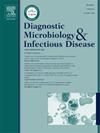非哺乳期妇女由bivia普氏菌引起的厌氧性乳房脓肿:一例诊断和临床意义的报告。
IF 1.8
4区 医学
Q3 INFECTIOUS DISEASES
Diagnostic microbiology and infectious disease
Pub Date : 2025-09-17
DOI:10.1016/j.diagmicrobio.2025.117112
引用次数: 0
摘要
背景和临床意义:bivia普氏菌是一种革兰氏阴性厌氧菌,通常与盆腔和生殖道感染有关。它与乳腺脓肿分离,特别是在非产褥期妇女中,是极为罕见的。病例介绍:我们报告一个独特的情况下,一个40岁的非哺乳期妇女提出复发性右乳房脓肿。患者在三年内(2022-2025)经历了三次发作;使用MALDI-TOF ms鉴定,只有第4次被微生物学证实是由双胞杆菌引起的,抗菌药物敏感性试验显示对氨苄西林耐药,对阿莫西林/克拉维酸和其他药物敏感。结论:该病例强调了厌氧培养和先进的识别技术在复发性乳房感染中的关键作用。虽然微生物学证实仅在最近一次发作中获得,但复发的临床图片提示难以培养的微生物病因学。本文章由计算机程序翻译,如有差异,请以英文原文为准。
Anaerobic breast abscess caused by Prevotella bivia in non-lactating woman: A case report with diagnostic and clinical implications
Background and Clinical Significance
Prevotella bivia is an anaerobic Gram-negative bacillus commonly associated with pelvic and genital tract infections. Its isolation from breast abscesses, particularly in nonpuerperal women, is extremely uncommon.
Case presentation
We report a unique case of a 40-year-old non- lactating woman presenting with a recurrent right breast abscess. The pa- tient experienced three episodes over three years (2022–2025); only the fourth episode was microbiologically confirmed as being caused by P. bivia, identi- fied using MALDI-TOF MS. Antimicrobial susceptibility testing revealed resistance to ampicillin and susceptibility to amoxicillin/clavulanic acid and other agents.
Conclusion
The case underlines the critical role of anaerobic cultures and advanced identification techniques in recurrent breast infections. Although microbiological confirmation was achieved only in the latest episode, the recurrent clinical picture suggests a difficult-to-culture microbial aetiology.
求助全文
通过发布文献求助,成功后即可免费获取论文全文。
去求助
来源期刊
CiteScore
5.30
自引率
3.40%
发文量
149
审稿时长
56 days
期刊介绍:
Diagnostic Microbiology and Infectious Disease keeps you informed of the latest developments in clinical microbiology and the diagnosis and treatment of infectious diseases. Packed with rigorously peer-reviewed articles and studies in bacteriology, immunology, immunoserology, infectious diseases, mycology, parasitology, and virology, the journal examines new procedures, unusual cases, controversial issues, and important new literature. Diagnostic Microbiology and Infectious Disease distinguished independent editorial board, consisting of experts from many medical specialties, ensures you extensive and authoritative coverage.

 求助内容:
求助内容: 应助结果提醒方式:
应助结果提醒方式:


